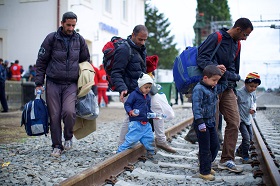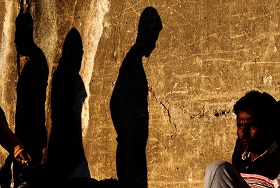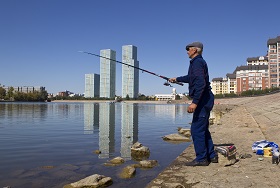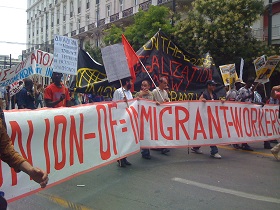Migration, Globalization and Economic Viability: Challenges and Opportunities for Russia & Eurasia
In
Login if you are already registered
(votes: 2, rating: 3) |
(2 votes) |
President, Global Migration Policy Associates
Migration today is demonstrably central to the viability of labour markets worldwide. It is key to obtaining return on capital in a globalized economy. It is key to development. Indeed the very survival of the world's developed economies depends on migration. Manifestations of anti-foreigner sentiments and xenophobia pose a visible challenge to social cohesion. And to attracting and maintaining the work force needed to sustain development.
Presentation Text at International Conference “Transnational Migration and Modern States in the Period of Economic Crisis”, Moscow, 25 September 2015.
I am honored by this opportunity to present global perspective on a major challenge and opportunity of our time. My remarks feature three dimensions: 1) migration sustaining the world of work today — in other words why immigration to Russia; 2) greater labour and skills mobility in coming years: prospects for Russia and Eurasia; and 3) challenges and opportunities for a viable law and policy regime on migration governance for Russia and Eurasia.
1) Setting the Context: Migration Today
Migration today is indisputably key to sustaining the world of work in the Twenty-First Century. Here as elsewhere, migration is internationalized labour and skills mobility in a globalized world.
ILO calculated that 105 million of the 214 million people living outside their countries of birth or origin in 2010 were economically active [1]. That is to say: employed, self-employed or otherwise engaged in remunerative activity. Given an estimate of one accompanying dependent for each active adult, 90 per cent of migration results in people being economically active or dependent on those who are [2].
By migrant, we refer to the UN definition that counts the foreign-born who are resident for a year or more outside their country of birth or citizenship. The UN Population Division shows a global estimate for 2013 of 232 million migrants worldwide (migrant stock), based on data supplied by governments. But that is a major undercount, it doesn't account for millions of short term, temporary and seasonal migrants, nor cross border mobile workers, who do not change country of registered residence.
Migration today is demonstrably central to the viability of labour markets worldwide. It is key to obtaining return on capital in a globalized economy. It is key to development. Indeed the very survival of the world's developed economies depends on migration.

Migration – A Challenge of Time
Migration rejuvenates workforces, maintains viability of agriculture, construction, health care, hotel, restaurant and tourism and other sectors, meets growing demand for skills, and promotes entrepreneurship. Migrant remittances, transfer of skills, investments, and expanded trade enhance development and well-being in many countries.
Migration represents growing portions of work forces in many countries across Asia, the Americas, the Caribbean, Europe and Eurasia. Foreign born workers comprise 10% to 15% of labour forces in Western European countries and around 18% in immigration countries of Australia, Canada and the USA [3], and from 40% to 93% of work forces in member States of the Gulf Cooperation Council (GCC). It is 10 to 20% across Eurasia.
Foreign-born people are 10% of the population of Eurasia, some 24 million people –equivalent to the region's 3th largest country in population. The numbers in Russia are 10.2% --11 million foreign born among the population (2013). 70% of the migrant population across Eurasia is working age, 80% in the Russian Federation. Most of these migrants working, economically active, women as well as men. In the Eurasia region, half of this population is female, similar to the global proportion. Meanwhile, from 5 to 33 per cent of labour forces of Eurasian countries are residing abroad.
Labour Mobility and Regional Economic Integration:

Konstantin Voronov:
Migration Tsunami from the South: EU
Communitarian Policy and National Egoism
Most migration is taking place within regions – not between. And specifically within the thirteen Regional Economic Communities that have established or are negotiating formal regimes of free circulation of persons. These involve over 120 countries. 80% of migration originating in West Africa goes to other member states of the ECOWAS, about the proportion of migration originating in Eurasian countries that goes to the Russian Federation and Kazakhstan. It is 50 to 60% in the European Union, South America's Mercosur and the Southern African Development Community.
This reflects the reality that free movement is the pillar of economic integration and development worldwide. Free movement of capital, goods, services, technology and people. Free movement, exercised in regional economic communities, puts skills and labour where its needed to spur investment and economic development. Indeed, the challenges of enhancing needed regional labour and skills mobility are now on the agenda of the Shanghai Cooperation Organization.
Economic importance of migration
Recent figures indicate that the annual flow of remittances is more than 500 billion US dollars [4] . Some estimates exceed $600 billion. That is four times larger than total annual official overseas development assistance (ODA – “foreign aid”); $135.1 in 2014 [5]. But remittances generally comprise less than 20% – at most – of migrant earnings.
A more comprehensive measure of value of economic activity by migrants to host countries is 2.5 to 3 trillion dollars, measured by extrapolation of aggregate direct earnings. That does not include the value added by migrants’ labour not returned to workers in remuneration but that adds to the worth of employers.
A World Bank Lead Economist highlighted that "In general the input of labor migrants into the Russian economy is estimated at 5-10 per cent of Russia's GDP." [6]
Sectoral distribution of migrant employment in Russia shows de facto where needs are: 40 per cent of migrant workers engaged in construction, 30 per cent in commerce, 10 per cent in industry, 7 per cent in agriculture, 5 per cent in transport industry, 8 per cent in other activities, according to official data [7].
At what cost?
Lest we only see a utilitarian economic dimension, I remind migration is about people, indeed it is people. In a globalized world dominated by capitalist economic relations, governing migration is about decent work, labour relations, social protection and social cohesion.
The questions posed for this session emphasize the extent to which the people dimension has to prevail to obtain success on migration policy: “Successful competition for skills and labour.” “Development of human capital.” “Harmonizing the legal regime.”
As much as migration is sustaining viable economies, it is about how people are treated. Ten characteristics describe the experience of a large proportion of migrants in most countries today. You can judge what applies in the Russian Federation.
1. Lack of legal protection, non-recognition of migrants; non-recognition of their rights under law.
2. Utilitarian instrumentalization of migrants and migration, explicitly subordinating migrants as human beings to economic considerations and market interests.
3. Criminalization of migrants, illegalization of people.
4. Prevalence of sub-standard, abusive employment relations and conditions of work.
5. Increasing xenophobic hostility and violence against migrants and refugees.
6. Systematic and structural discrimination against and exploitation of migrant women.
7. Suppression of migrant worker organization and of migrant participation in social organization.
8. Lack of access to health care and Occupational Safety and Health (OSH) protection.
9. Absence of social protection and of social security access and portability for many migrants.
10. Family separation, disruption and decomposition.
Exploitative conditions commonly experienced by migrants are structurally driven. For many enterprises in many countries, for entire economic sectors, low cost foreign labour is the only ticket to survival. Certainly here in Russia.
Labour dependent agriculture would not be viable in Europe nor in North America nor in South Africa --nor could a part of the population afford to eat-- without cheap immigrant labour. Health, home care and schooling for children and care for populations of ageing people increasingly depend on migrants –as do hotel, restaurant and tourist sectors in many countries. Global competition, free trade, and the race to the bottom phenomena push against costs of labour and provision of social services; they challenge the very social function of States.
Keeping some migrants cheap, docile, flexible and removable without social costs-- becomes not just highly desirable. It becomes imperative to keep jobs at home and economies afloat, no matter what those jobs are and who is doing them. Despite rhetoric about controlling migration, migrant workers remain in irregular situations, tolerated because they provide that cheap, flexible labour needed to sustain enterprises, employment and competitiveness. But at high social and human cost.
Anti-foreigner hostility
Manifestations of anti-foreigner sentiments and xenophobia pose a visible challenge to social cohesion. And to attracting and maintaining the work force needed to sustain development. It's a big challenge here, as already alluded to in this conference.
Public pronouncements and political discourse often attribute crisis-induced unemployment and economic problems to immigration. Anti-immigrant manifestations and policy reactions contribute to an environment that discourages political will and public support, impeding immigration and extension of social protection for an important part of the population. They also carry a significant economic cost in rendering countries unattractive in the increasingly competitive international markets for talent, skills and labour.
2. Greater mobility anticipated
Within 15 years, the majority of world's countries and populations will be in serious work force decline [8]. Germany loses 5 million members of its work force in the next fifteen years. The Russian Federation has lost 10 million since 2000, with a current rate of reduction of close to 1 million workers per year in its domestic labour force. The Japanese labour force is shrinking by 37% between 1990 and 2040. A study says that Switzerland needs 400,000 additional workers by 2030. And there's the big one: China's work force declines by 100 million people in the next 30 years.
Some 122 of 224 recognized countries and political territories are at or well below zero population growth fertility rates [9]. Over coming years, all face increasing departures from the work force uncompensated by decreasing numbers of youth entrants. Many already do. This means increasingly 'globalized' demand – and competition – for what has become the most crucial economic resource of all today: trained skills and talent at all levels.
Projections show demographic ageing and decline of native work forces continuing unabated over coming years in Armenia, Azerbaijan Belarus, Georgia, Moldova, Russian Federation, the Ukraine and Uzbekistan. Trends in Kazakhstan suggest that current modest population growth will not be sustained.
Supply side pressures
Pressures for labour displacement and emigration from countries North and South remain intense; in some situations they have significantly intensified in the last five years. The main factor remains the absence of jobs and decent work in countries with growing youth populations.
Meanwhile, financial crises and austerity measures that devastated national economies as well as social protection systems even in Europe have resulted in youth unemployment rates at or above 50% in several countries [10]. New waves of emigration, especially of young skilled workers, are departing from Greece, Ireland, Italy, Portugal and Spain.
However, departure of significant portions of the labour force including many skilled workers carries significant costs. Employers in numerous countries complain that they cannot maintain viable enterprises because many skilled technicians and workers leave to find work abroad [11].
Skills and training constraints
No country today can form or train the entire range and number of evolving skills needed to perform the ever more complex work performed on its territory. This drives a constantly increasing, international mobility of skills, competences, and labour at all skill levels.
The looming skills crisis is critical and worldwide. A forecasting study by the McKenzie Global Institute [12] estimated that the global shortage of high skilled and trained technical skills may reach 85 million by 2020. 38–40 million skilled workers with tertiary education will be lacking, especially in developed countries. Another 45 million will be missing with technical and vocational skills needed by employers. This within five years when employers around the world – including in Eurasia – complain that they cannot fill one in three jobs on offer with the needed level of skills.
Institutional redefinition
Despite that migration is essentially about labour mobility, economic performance and employment, governance responsibilities on migration have been shifted to control and policing institutions of many States in all regions.
The locus of migration governance in immigration/migrant receiving States was generally in labour and employment ministries. That reflected the primacy of needs to regulate labour markets and to protect workers as well as oversee employment relations and social dialogue. Administration of increasing foreign components of work forces by control institutions has consequences in shifting emphasis of law enforcement regarding work from labour standards to immigration enforcement and in imposing policing solutions to labour conflicts at the expense of social dialogue.
Status, legal authorization and employment
Eurasians legally entitled to move freely from one country to another are nonetheless often considered "illegal migrants" when they are employed. A direct consequence is non-respect for labour rights and decent work standards, meaning abusive, exploitative conditions. The absence of legal recognition regimes adapted to realities of Eurasian labour mobility prevents accounting for and benefiting from that mobility. It impedes incorporating workers into social protection systems.
3. Which Way to Govern
Migration today is a major feature of Russia's economic viability and redevelopment.
- Migration is an essential resource for economic development and productivity;
- It is the key means of meeting shortages of skills and labour;
- It compensates for declining work forces and aging populations;
- It is key to regional economic integration ensuring development and public well-being.
Yet migration will only yield its benefits for nations and peoples with law and policy that:
- Provides legal recognition and protection for all migrants;
- Facilitates regular labour and skills mobility in response to real labour market and employer needs;
- Applies international labour standards to ensure decent work conditions for all workers;
- Assures full protection for working women with gender sensitive law and policy.
- Guarantees social cohesion by preventing xenophobia and facilitating integration.
- Extends social and health protection and social security access for migrants;
- Enhances training and education of needed professional, technical and vocational skills;
The following policy agenda, derived from successful national experiences and validated in international conferences, provides appropriate guidance and perhaps a relevant model for Russia.
1. Full recognition and legal protection of all migrants
Ratification and full implementation of key legal standards on migration and migrants rights: the 1990 International Convention on the Protection of the Rights of All Migrant Workers and Members of Their Families, ILO Convention No. 97 on migration for employment and ILO Convention 143 on migrant workers (supplemental provisions). This to set governance of migration on a firm footing of the rule of law, in order to strengthen legitimacy of policy and the accountability of institutions..
2. Rights and people based discourse
Identifying migrants as persons and rights-holders first and foremost in legislation and discourse
3. Decriminalization of migrants, refugees, and migration:
Enactment of legislation and policy that define migration offenses as civil or administrative, not criminal.
4. Decent Work for all migrants:
Domestication of international labour standards with explicit applicability to all workers and vigorous enforcement of labour standards and regulated employment relations, in order to sustain a protected, productive, competitive labour force and stimulate viable labour markets.
5. Gender-specific migration legislation and policy
Ensuring equality of rights, opportunities and protection for all migrant women and girls.
6. Stop Xenophobia, racism and discrimination against migrants
Repeal discriminatory legislation; discourage xenophobic discourse, and implement a national action plans against discrimination and xenophobia. Only deliberate initiative by the State will restore the social cohesion necessary for a functioning economy, society and country.
7. Support freedom of association participation of migrants in unions and associations
Implement fully international standards ratified by Russia on freedom of association and collective bargaining, for migrant workers as well as nationals. Facilitate participation of social partners in migration policy and practice; only stakeholder involvement ensures getting it right and making it happen in practice with cooperation of all.
8. Health for all migrants (health is a right for all).
Provide full access by migrants to health prevention and care services and facilities and elaborate national public health and OSH policy on health for migrants; a healthy population is a productive population.
9. Social Security for migrants
Immediate unilateral measures to extend coverage and portability to migrants and harmonize social security access in the Eurasia regional integration space. (An effort is already initiated among national social security administrations with support from ISSA - International Social Security Association).
10. Family Unity and family support
Legislating family unity provisions in immigration regimes; Enacting measures to sustain socialization and education for children remaining at home as well as for migrant and refugee children.
In Conclusion
History tells that migration has always been an essential ingredient of development and human welfare. It is all the more so in Russia today and across Eurasia. However, unless regulated by appropriate laws and policies, migration entails high costs. Accomplishing effective governance of migration ought to be a recommendation of this conference and on the agenda for followup action.
1. ILO, International Labour Migration: a Rights Based Approach, International Labour Office, Geneva,2010, p. 1.
2. ibid
3. Recent figures for most EU countries and “immigration countries” mentioned are found in the OECD International Migration Outlook: SOPEMI 2011 Statistical Annex
4. World Bank. “Migration and Remittances.” September 2, 2014.
5. OECD on-line report. See: http://www.oecd.org/dac/stats/development-aid-stable-in-2014-but-flows-to-poorest-countries-still-falling.htm
6. Sudharshan Canagarajah, quoted in "World Bank A Catalyst for Labor Migration Discussions", Online profile, WB, Washington D.C., undated.
7. Polskikh, Vladislav. Labour Migration To Russia, Youth Research Group "Nota Bene", Russian Federation, nd/2008?
8. For a corporate view on the phenomena, see Ernst & Young online report: “Six global trends shaping the business world: Demographic shifts transform the global workforce” at http://www.ey.com/GL/en/Issues/Business-environment/Six-global-trends-shaping-the-business-world - Demographic-shifts-transform-the-global-workforce
9. This and following figures drawn from the on-line CIA World Factbook, Country Comparison: Total Fertility Rate (s) at https://www.cia.gov/library/publications/the-world-factbook/rankorder/2127rank.html. 2.1 to 2.2 children per woman is considered the ‘replacement rate’ of zero population growth, below which population will decline.
10. Eurostat. Table 1: Youth Unemployment Figures, 2011-2013 Q4.
11. As observed in interviews by Mr. Patrick Taran with executives of employer organizations of Algeria, Kyrghyz Republic, Nigeria, Russia, Tajikistan and other countries, 2011-2014.
12. McKenzie Global Institute: 2012. The World at Work: Jobs, Pay and Skills for 3.5 Billion People. See http://www.mckinsey.com/insights/employment_and_growth/the_world_at_work. Summary and full text available for download on that page.
(votes: 2, rating: 3) |
(2 votes) |






